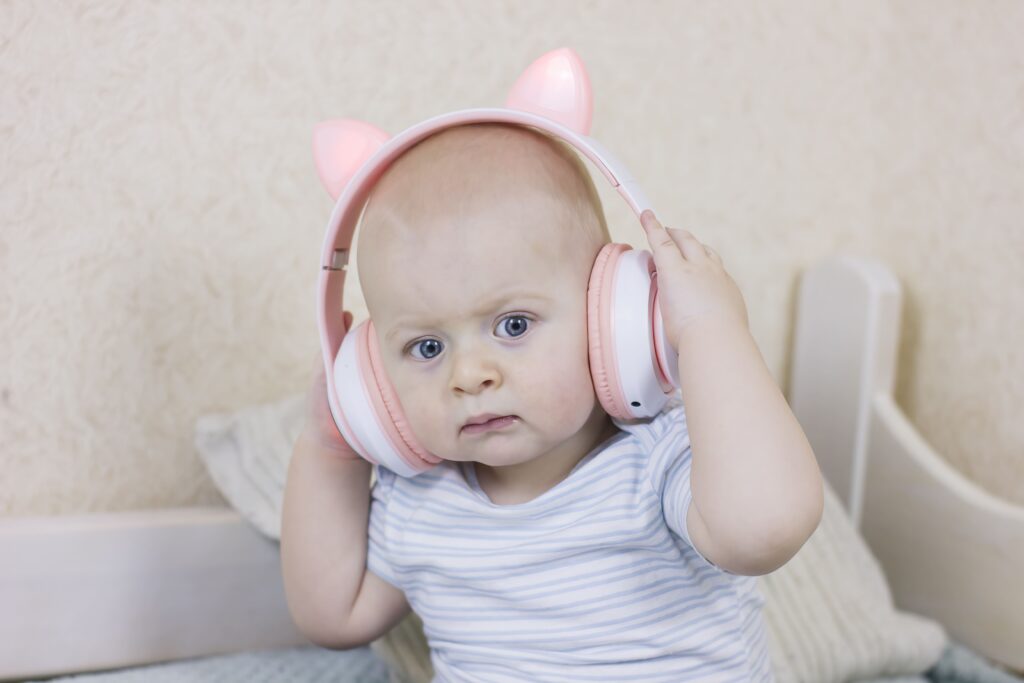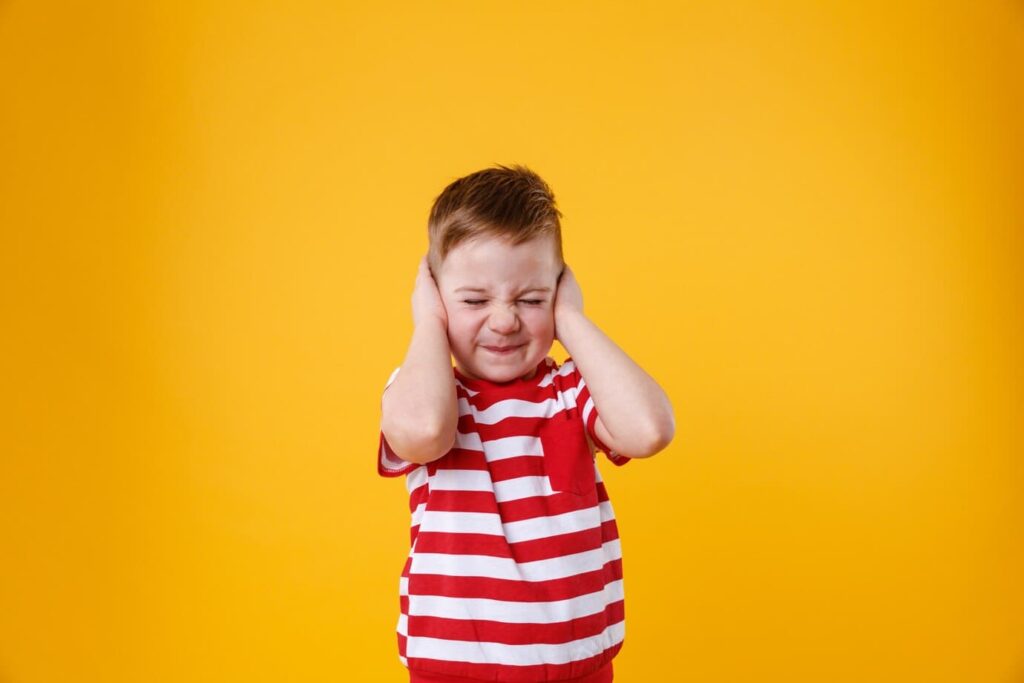Seeing your little one spontaneously stick their palms over their ears can be an adorable sight that captures a precious moment. Or it may signal something more serious than an impromptu game of peek-a-boo.
As a new parent, I was initially amused when my 8-month-old son would periodically smack his tiny hands over his ears, shutting out noise. “Aww, the blender must be annoying him,” I would chuckle. But when the behavior became more consistent, occurring multiple times a day, it stirred some worry.
Was my baby’s hearing extra sensitive? Did he have an ear infection causing discomfort? Or could it indicate sensory processing issues? My mind spun with questions.
To get answers, I did some digging into the common phenomenon of baby covering ears with hands and reasons behind this “cute or concerning” reflex. Here’s what I uncovered…
When Do Babies Start Intentionally Covering Ears?
It’s natural for infants to begin examining their own features early on as cognitive skills advance. Swiping at ears, nose, and mouth happens as early as 2 months old in curious babies mapping out their bodies through “hand regard.”
By 4-6 months, babies discover they can manually manipulate parts of the face. Ear tugging, pinching, and patting kicks off as your child determines ears can move and make fun noises! They learn covering them muffles sound.
Frequent, sustained ear covering emerges around 5-6 months when your baby associates the effect of blocking noise by cupping their ears shut. It rarely indicates issues on its own at this age. But consistent ear holding past 10 months warrants a closer look.

Why Do Babies Cover Their Ears So Much?
For infants, listening to the world unfold is thrilling but also overwhelming at times. Sheltering their ears helps regulate input from loud volumes. Here are common reasons babies cover ears:
Exploring New Body Parts
Your child is wired to discover what ears do through cause-and-effect trials. Clasping them is stimulating and reforms their shape in amusing ways!
Testing Sensory Stimuli
Covering ears reveals intriguing differences in hearing muffled versus clear sounds. Babies still developing auditory perception test extremes.
Shutting Out Discomfort
Loud appliances, vehicles or crowds can hurt tender eardrums. Blocking noise brings relief while their auditory resilience strengthens.
Self-Soothing
The rhythmic pressure of pushing ears provides comforting tactile feedback. Some babies even discover emitting vibration by “motorboating” lips while ears covered!
Mimicking Observed Behaviors
Seeing parents or siblings cover ears in response to noises gets mirrored. Babies imitate familiar acts.
If you notice consistency around loud triggers or duration beyond their age level, hearing sensitivity may be a factor.
Signs Your Baby Has Sensitive Hearing
While healthy babies shouldn’t be too bothered by reasonable volumes, some do have lower thresholds. Watch for these responses indicating extra-sensitive hearing:
- Frequently covers ears with certain repetitive sounds
- Cries, grimaces or stops play/feeding when loud sounds occur
- Flinches, startles or blinks reflexively to noises
- Distress escalating the closer sound source
- Fussy after prolonged noise exposure
If you observe these reactions frequently, consult your pediatrician on steps to support your sensitive baby’s needs while fostering noise desensitization.

Can Ear Covering Indicate Sensory Processing Issues?
Babies who seem agonized by everyday sounds despite calming efforts may have an auditory processing problem. Their brain and nervous system misinterpret input.
Sensory processing disorder is often first suspected when children consistently cover ears around usual volumes most kids tolerate well. Detecting symptoms early allows intervention through therapies improving regulation.
But it’s crucial to distinguish between manageable sensitivity versus disordered. Not all babies bothered by noise have sensory dysfunction. An occupational therapist can determine next steps.
What Else Can Cause Frequent Ear Covering?
While examination of new body parts explains most cases of brief bouts of ear covering in young babies, some alternatives include:
Ear Infections
Discomfort from ailments like inner/outer ear infections may lead to recurrent ear holding. Especially if paired with discharge, fever or sleep problems.
Autism Markers
Excessive ear covering by 8 months that continues absent noise may signal autism spectrum disorder or language delays.
Self-Injury
Aggressive, habitual pressing on ears can bruise cartilage. Inform doctors of reddening, swelling or postural changes.
Ear covering shouldn’t be painful, leave marks or constantly interfere with play. Seek medical guidance for any adverse effects.
Red Flags – When to Arrange Hearing Testing
While most ear covering in babies under 1 year old proves harmless, consistent concerning symptoms warrant assessment such as:
- No reaction when loud sounds occur, even if nearby
- Delayed babbling/speech development
- Frequent mouth breathing and snoring
- Chronic ear pulling/rubbing
- Recurrent ear drainage or infections
See your pediatrician promptly if you notice these or ask around 12 months about a hearing evaluation checking auditory processing and speech markers. Early intervention aids optimal outcomes.
Supporting Your Baby’s Sensory Needs
If your baby’s hearing sensitivity impedes daily life, try these accommodations managing stimulation:
Modify Environments
Dim loud settings by minimizing device volume, adding carpet/curtains, and leaving noisy areas.
Offer Ear Protection
Earmuffs, noise cancelling headphones or ear plugs aid sound blocking but don’t leave unsupervised!
Teach Coping Skills
Demonstrate covering ears then resume play signaling noise immersion. Praise calming efforts.
Expose Gradually
Briefly turn on vacuum/blender then increase duration. Applaud brave behavior!
Prompt Before Loud Events
Warn baby “loud noise coming” and describe expected sensations so they anticipate intensity changes.
Discover Triggers
Track responses to detect most bothersome pitches guiding accommodations.
Consider occupational therapy addressing sensory defensiveness if despite best efforts, sound struggles persist hindering your baby’s functioning.
Discussing any recurring behaviors impeding your baby’s growth with your pediatrician is wise even if likely harmless. Addressing problems early often allows quick resolution!
While my son’s ear covering initially struck me as sweet infant play, monitoring for patterns helped distinguish his sensitivity requiring accommodation. His occupational therapy now builds coping methods so he learns the beautiful (yet sometimes unpleasant!) nuances of sound.
For your little ear defender, consistent baby ear covering could reflect harmless development. But should duration or triggers seem atypical, conservatively assessing why with experts can make all the difference giving them the tools they need growing up!
FAQ – Baby covering ears with hands
Why do babies cover their ears with their hands?
Babies may cover their ears with their hands for various reasons, such as being sensitive to loud noises, feeling overwhelmed or overstimulated, feeling scared or embarrassed, or having an ear infection. Sometimes, covering their ears with their hands is a way of self-soothing or blocking out unwanted sounds.
Is it normal for babies to cover their ears with their hands?
Yes, it is normal for babies to cover their ears with their hands occasionally, especially when they are exposed to new or loud sounds, or when they are in unfamiliar or stressful situations. However, if your baby covers their ears with their hands frequently, persistently, or excessively, it may indicate a problem with their hearing, their ear health, or their sensory processing.
How can I tell if my baby has a hearing problem or an ear infection?
Some signs that your baby may have a hearing problem or an ear infection are:
- They do not respond to your voice or other sounds, or they respond inconsistently.
- They pull or rub their ears, or they wince or cry when you touch their ears.
- They have trouble sleeping, feeding, or balancing.
- They have fever, ear discharge, or swelling around their ears.
- They have delayed speech or language development, or they regress in their communication skills.
If you notice any of these signs, you should consult your pediatrician or an audiologist as soon as possible.
How can I help my baby cope with loud noises or sensory overload?
Some ways to help your baby cope with loud noises or sensory overload are:
- Avoid exposing your baby to unnecessary or excessive noise, such as loud music, TV, or crowds.
- Provide your baby with a quiet and comfortable place to rest and relax, such as their crib, a cozy corner, or a dimly lit room.
- Use soothing sounds, such as white noise, soft music, or a familiar voice, to calm your baby or mask unwanted noise.
- Offer your baby a pacifier, a blanket, a stuffed toy, or a hug to comfort them and make them feel secure.
- Respect your baby’s cues and preferences, and do not force them to interact with people or things that make them uncomfortable or unhappy.
When should I be concerned about my baby covering their ears with their hands?
You should be concerned about your baby covering their ears with their hands if:
- They do it very often, for a long time, or in response to normal or low-level sounds.
- They do it along with other unusual behaviors, such as avoiding eye contact, rocking, spinning, or flapping their hands.
- They do it to the point of hurting themselves or others, such as scratching, biting, or hitting their ears or head.
- They do it and show signs of distress, such as crying, screaming, or panicking.
These behaviors may indicate a more serious issue, such as autism spectrum disorder, sensory processing disorder, or anxiety disorder. If you have any concerns about your baby’s development or behavior, you should talk to your pediatrician or a developmental specialist.











